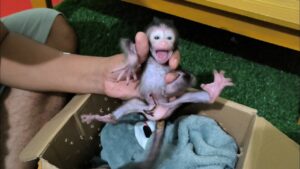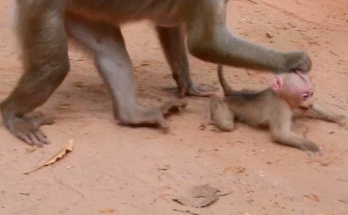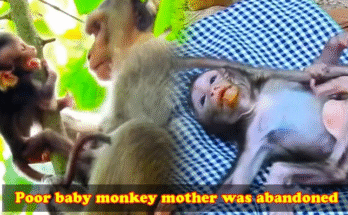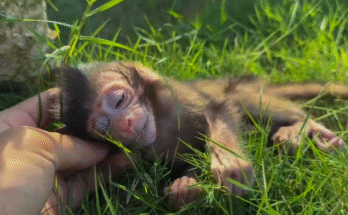In the heart of a lush rainforest, where the sounds of chirping birds blend with the gentle rustle of leaves, a tiny life clung to the world with delicate strength. A newborn baby monkey had just entered the forest, and unlike most of its kind, it arrived in a situation that demanded immediate attention. Its umbilical cord was still attached, a sign of its very recent birth, but also a symbol of its vulnerability.

Rescue teams who work tirelessly in these remote regions are trained to handle such fragile situations. For a newborn, every moment counts, and the presence of the umbilical cord adds both urgency and a need for careful handling. These tiny creatures, with their soft fur and trusting eyes, cannot fend for themselves at birth, making human intervention crucial for their survival when circumstances become dangerous.
The process of rescuing a newborn monkey is delicate. Caregivers first assess the baby’s vital signs—its breathing, responsiveness, and temperature—ensuring it is stable enough to be moved. The umbilical cord, still attached to the placenta, must be handled with extreme care to prevent infection. In many cases, the cord is cleaned and gently tied off in a sterile manner to mimic natural conditions as closely as possible. Each movement is slow and intentional, because even the slightest disturbance can be stressful for such a young and fragile animal.
Once stabilized, the baby monkey is given warmth and comfort, often using soft cloths or a small heated space to replicate the mother’s presence. These creatures are not only physically delicate but also emotionally sensitive. Human rescuers act as temporary caregivers, offering gentle touch and soothing sounds to calm the newborn. This initial bonding period is critical, as it helps the baby adapt to the sudden transition from its natural environment to a safe, controlled space.
Nutrition is another vital aspect of the rescue. In the wild, a newborn would feed on its mother’s milk, gaining the strength needed to grow and develop. In a rescue scenario, specialized formula replicates the nutritional profile of natural milk, ensuring the baby receives all the essential vitamins and antibodies needed for healthy development. Feeding is done frequently, as newborn monkeys have small stomachs and require constant nourishment. Each feeding session strengthens the baby’s body and builds trust between the caregiver and the tiny primate.
As days pass, the rescued monkey slowly gains strength. Its eyes grow brighter, its movements more coordinated, and its voice, once weak and uncertain, begins to carry a more confident tone. Rescue workers celebrate these small milestones, knowing that every bit of progress brings the baby closer to a full recovery. The ultimate goal is to reintroduce the monkey to a safe natural habitat, where it can grow, explore, and eventually thrive among others of its species.
Stories of such rescues remind us of the incredible responsibility humans have in protecting the vulnerable creatures who share our world. Each life, no matter how small, holds value and deserves compassion. Observing a newborn monkey being nurtured back to health not only inspires awe but also encourages broader awareness of wildlife conservation. The forest, once echoing only with the calls of the wild, now carries a new song—a song of hope, care, and second chances.
In moments like these, the importance of quick action, gentle care, and dedicated effort becomes clear. A tiny monkey, born into uncertainty and danger, can grow strong with the right support. Every touch, every careful movement, and every feeding is a testament to the commitment of those who dedicate themselves to saving lives, ensuring that even the most fragile beings have a chance to flourish in the wild.


